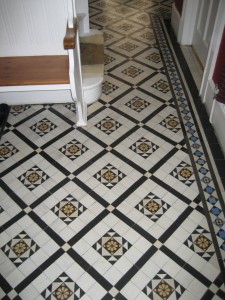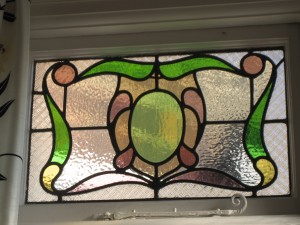Our house was one of the last of our terrace to be built before the First World War. With the coming of conflict, the rapid development that had created Palmers Green as we know it had come to a sudden halt. A few plots remained empty for some years, like runs of missing teeth between the new pristine rows.
The view northward to the end of our road in 1914 would have been to Bourne Hill, and then on into arable or grazing land, perhaps with a tantalising glimpse of Winchmore Hill in the middle distance. Perhaps, with the coming of the war, some pockets of farmland nearer at hand got a stay of execution. I hope that they were a great play space for Palmers Green’s newly arrived children – some small consolation while their families worried over the news in Europe and what it would mean for them…
I have always been fascinated by the history of our house and those around it. We are lucky that our house still has a few original features – we still uncover a little surprise here and there lurking beneath Edwardian raised pattern wallpaper and the efforts of decades of home improvers – the outline of our old wooden fire surround, the route of gas lighting, the outline of where the ‘copper’ once stood in the scullery, maybe once tended by a maid-of-all-work.
The first occupant of our house, according to Kelly’s directory, was Henry George Wort. Henry appears to have been born in Clerkenwell around about 1861, and a rummage through the 1911 census indicates that Henry’s previous residence was probably 126 St George’s Avenue in Tufnell Park, showing that the trend for Palmers Greeners to be refugees from inner north London is nothing new.
Henry had married his wife Elizabeth in 1887, and so they had been together more than 25 years by the time they moved into their brand new house in Palmers Green. Though they were 52 and 49 respectively, they had had no children.
The Worts were here for over 20 years. Elizabeth died in March 1936 and Henry outlived her by four years – he was nearly 80 when he died in November 1940, having lived in our house in two world wars. What must it have been like for him then I wonder, to arrive in Palmers Green on the brink of one world war, and then lived in it into the second. Some of our glass dates from the wartime (if your glass has an uneven ripple, perhaps some of yours does too) – and I can’t help wondering if the originals were blown out by an explosion and replaced while he lived here.
But I am getting ahead of myself. The building of our house had caused some ruffling of feathers in the local area – for the houses being planned by Mr Byford on our corner of Clappers Green Farm were to be terraces, and not even the aesthetically pleasing ‘linked’ terraces you find occasionally in this area. What’s more, they were to have only 3-4 bedrooms. Cheap properties were thought to be likely to attract lower class people such as bank workers and civil servants, not at all what those in the Lakes Estate had in mind as neighbours.
Henry Wort in this respect appears to be an enigma, for the census for 1911, two years before he came to Palmers Green, indicates that he was an assistant teacher, a less senior occupation than perhaps might have been expected even for our humble house, though Henry left more than three thousand pound on his death. Perhaps he moved here to take up a new post in one of the fast expanding local schools?

We don’t know if he was an owner occupier or a renter, but if it was the former, he and Elizabeth were likely to have been responsible for choosing our fixtures and fittings – the colour of the floor tiles, the coloured glass, the fireplace and the hearth tiles. Purchasers of newbuilds were given the opportunity to choose smaller details from a catalogue, which is why you will see some similar flourishes in your neighbours’ houses, but not necessarily in the same order.
The colours that Henry and Elizabeth chose have presented a bit of a challenge to subsequent generations. Dark green, dusky pink, burgundy and yellow, with smatterings of blue… By the time we first set foot inside in 2007, we had a house with pistachio walls and pink carpet in the back room, Lincoln green carpet and canary yellow walls in the bedroom and, in the hall, blue green carpet and walls with a contrasting paper border, the carpet fixed by drilling holes into the original tiled floor. Ho hum.
 Somehow, even when facing these aesthetic challenges, the house has always felt happy, warm and welcoming. There have been many occupants since Henry Wort. Periods of rental mean that parts of the original house are still here that could easily have been lost to unsympathetic builders and home improvers.
Somehow, even when facing these aesthetic challenges, the house has always felt happy, warm and welcoming. There have been many occupants since Henry Wort. Periods of rental mean that parts of the original house are still here that could easily have been lost to unsympathetic builders and home improvers.
We often thank Henry Wort for his house – and Henry and Elizabeth, we promise to always look after it.
This article also appears in the September issue of Palmers Green Life
2 replies on “Thank you, Henry Wort”
Hi Lesley, thats interesting!
. I knew that Henry had been an assistant schoolteacher in tufnell park before hw came here- 1911 census. i had assumed that he would have been a renter as so many were of the first edwardians here. i am guessing that he moved for promotion. and the will description of schoolmaster indicates that he certainly did move upward in the world. i wonder where he taught…
Three thousand pounds is a huge amount to die with in the 1940s. Does that include all assets? The house too i am guessing. When kate and i were looking at this at the local history library we noticed that the probate stuff was processsed in llandudno. Did they move records there because of the conflict do you know?
Have you looked into the history of your own house? wouldnt it be fascinating to know more about the first people who lived here post the great expansion. If you would like to contribute anything on this for the site or on any other topic sometime, i would love it. Do drop me an email if you do
all v best
I am keen on Genealogy and looking at Ancestry Wills and Probate entries
Henry George Wort died on 25 Jan 1941 probate 22 Mar £3229 14s 6d to Henry Frederick Wilks and Henry George Cooper.
Elizabeth Jane died 17 Jan 1936 probate 21 Feb to Henry George school master.
Judging by the amount left by Henry he seems to have owned the house in his name only.